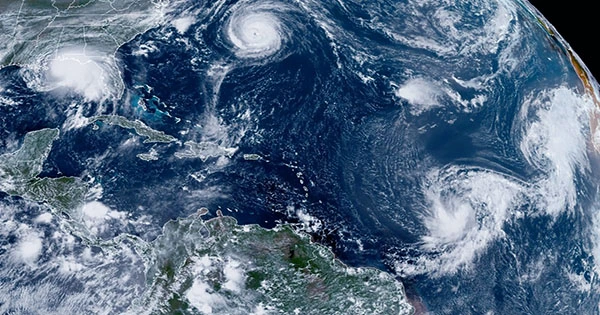Hold on to your hats: the Atlantic hurricane season is shaping up to be another brutal one. The most recent projections are in, and all expect above-average activity. Yesterday, the National Oceanic and Atmospheric Administration (NOAA) announced its forecast for the 2022 Atlantic hurricane season, projecting a 65 percent likelihood of an above-normal season, a 25% chance of a near-normal season, and just a 10% risk of a below-normal season.
This translates to 14 to 21 named storms with winds of at least 62.8 kilometers per hour (39 miles per hour). Six to ten of them might develop into hurricanes with winds of 119.1 kilometers per hour (74 miles per hour) or higher, including three to six major storms with winds of 178.6 kilometers per hour (111 miles per hour) or higher. Colorado State University has forecasted an active hurricane season, projecting 19 named storms and 9 hurricanes, up from the average of 14.4 named storms and 7.2 hurricanes from 1991 to 2020.
If the forecasts are correct, 2022 will be the eighth consecutive year with above-average storm activity. The Atlantic hurricane season officially extends from June to November, with peak activity in September, when hurricanes and storms are most prevalent in the North Atlantic Ocean. Some hurricanes may make landfall in the Caribbean and southern US coastal areas like as Florida, Louisiana, Texas, North Carolina, and South Carolina, causing widespread destruction.
There are a numerous causes for the high number of hurricanes at this time, but the primary one is the differential in air and sea surface temperatures that builds up in the late summer. The persisting La Nia climatic phenomena is partially to blame for the heightened activity expected in the hurricane season of 2022.
El Nio refers to the warm phase when the Pacific’s hottest surface waters reside offshore of northwestern South America, whereas La Nia refers to the cold phase when sea surface temperatures are below average in the east-central Pacific. El Nio contributes to hurricane activity strengthening in the central and eastern Pacific basins while suppressing it in the Atlantic basin. Because a big El Nio is improbable, hurricane activity in the Atlantic will continue unabated, resulting in a busier hurricane season in the Atlantic. We should expect additional damage and destruction to sections of the east coast as a result of the increasing storm activity.
“As we prepare for another potentially active hurricane season, historical storms like Superstorm Sandy, which ravaged the New York metro region 10 years ago, remind us that the damage of a single storm may last for years,” said NOAA Administrator Dr Rick Spinrad. “Being storm resilient and climate-ready requires early preparation and knowledge of your risk,” said Secretary of Commerce Gina M Raimondo. “Throughout the hurricane season, NOAA specialists will work around the clock to deliver timely and accurate predictions and alerts so that residents in hurricane paths may stay informed.”
















